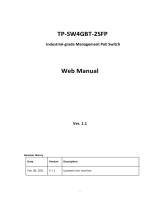
© Copyright 2015 TRENDnet. All Rights Reserved.
Contents
PRODUCT OVERVIEW .......................................................................................................2
F
EATURES
............................................................................................................................................
2
FRONT
V
IEW
.......................................................................................................................................
3
LED
I
NDICATORS
...............................................................................................................................
3
REAR VIEW
.........................................................................................................................................
5
PACKAGE
C
ONTENTS
.........................................................................................................................
5
SWITCH
INSTALLATION
...................................................................................................5
DESKTOP HARDWARE
I
NSTALLATION
............................................................................................
5
RACK MOUNT HARDWARE
I
NSTALLATION
....................................................................................
6
BASIC INSTALLATION
........................................................................................................................
6
CONNECT ADDITIONAL DEVICES TO YOUR SWITCH
.......................................................................
8
CONFIGURE YOUR
SWITCH
.............................................................................................9
ACCESS YOUR SWITCH MANAGEMENT PAGE
..................................................................................
9
SWITCH INFO
......................................................................................................................................
9
S
YSTEM
.............................................................................................................................................
11
PHYSICAL
I
NTERFACE
.....................................................................................................................
24
B
RIDGE
..............................................................................................................................................
27
SNMP
...............................................................................................................................................
62
ACCESS CONTROL
C
ONFIG
.............................................................................................................
71
RMON
..............................................................................................................................................
77
VOICE VLAN
...................................................................................................................................
83
S
ECURITY
..........................................................................................................................................
87
DESTINATION MAC
F
ILTER
..........................................................................................................
92
POWER OVER ETHERNET
C
ONFIGURATION
................................................................................
94
DHCP
S
NOOPING
............................................................................................................................
96
LLDP (LINK-LAYER DISCOVERY
P
ROTOCOL
) ........................................................................
100
S
TATISTIC
......................................................................................................................................
103
SWITCH
M
AINTENANCE
..............................................................................................................
105
SAVE SETTINGS TO
F
LASH
..........................................................................................................
113
WEB SMART SWITCH MANAGEMENT
UTILITY
..................................................
114
SYSTEM REQUIREMENTS .............................................................................................................114
INSTALLATION...............................................................................................................................114
USING THE
U
TILITY
......................................................................................................................115
DISCOVERY LIST............................................................................................................................116
DEVICE
S
ETTING
...........................................................................................................................117
MAIN MENU OPTIONS .................................................................................................................118
TECHNICAL
SPECIFICATIONS ...................................................................................
120
TROUBLESHOOTING
....................................................................................................
122
APPENDIX
........................................................................................................................
123
HOW TO FIND YOUR IP ADDRESS? .............................................................................................123
HOW TO FIND YOUR MAC ADDRESS
?
........................................................................................131
REGULATIONS
................................................................................................................
132
FEDERAL COMMUNICATION COMMISSION INTERFERENCE STATEMENT..................................132
ROHS..............................................................................................................................................132
EUROPE – EU DECLARATION OF
C
ONFORMITY .......................................................................133
LIMITED
WARRANTY ..................................................................................................
134






















